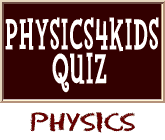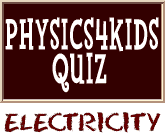An Alternating Current
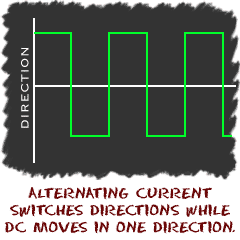 There are two main types of current in our world. One is direct current (DC), which is a constant stream of electrons in one direction. The other is alternating current, which is a stream of charges that reverses direction. Scientists such as Charles Proteus Steinmetz and Nikola Tesla made great advances when AC power was just a science experiment.
There are two main types of current in our world. One is direct current (DC), which is a constant stream of electrons in one direction. The other is alternating current, which is a stream of charges that reverses direction. Scientists such as Charles Proteus Steinmetz and Nikola Tesla made great advances when AC power was just a science experiment.
Flowing Back and Forth
Charges (electrons) must always be flowing to have a current. However, the flow of charges does not always have to be in one direction. In alternating current, the charges move in one direction for a very short time, and then they reverse direction. This happens over and over again.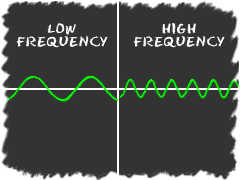 Scientists describe the cycle of switching directions as the frequency. Frequency is measured in Hertz (Hz). Currents that cycle more often during a specific amount of time are said to have a higher frequency. AC power cycles 60 times per second in the US.
Scientists describe the cycle of switching directions as the frequency. Frequency is measured in Hertz (Hz). Currents that cycle more often during a specific amount of time are said to have a higher frequency. AC power cycles 60 times per second in the US.
Since the web is a global resource, we should also mention that there are different alternating current frequencies across the world. While we all use alternating current, the switching happens different amounts during a specific time period. Most countries use AC frequencies at either 50 hertz or 60 hertz.
Cheaper and Stronger
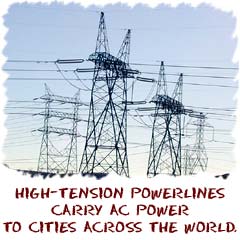 Why do we use AC power all over the world? It's cheaper and easier to make devices for AC power. It is less expensive because you can increase and decrease the current for AC power very easily. The power switches for AC power are also less expensive to manufacture. Probably the biggest advantage of AC is that you can use high voltages with small currents to reduce losses when you transmit power. Remember that lost energy increases the more collisions you have, and reducing current decreases the amount of collisions (and reduces heating in the wires). You can send power with DC, but the DC power transmission loses a lot of energy. You would have to put much more effort into sending DC power over the same distance.
Why do we use AC power all over the world? It's cheaper and easier to make devices for AC power. It is less expensive because you can increase and decrease the current for AC power very easily. The power switches for AC power are also less expensive to manufacture. Probably the biggest advantage of AC is that you can use high voltages with small currents to reduce losses when you transmit power. Remember that lost energy increases the more collisions you have, and reducing current decreases the amount of collisions (and reduces heating in the wires). You can send power with DC, but the DC power transmission loses a lot of energy. You would have to put much more effort into sending DC power over the same distance.
Alternating Around You
BIG NOTE: NEVER touch the outlets in your house. You will get electrocuted. There is more to electricity than voltage. It's the current that will kill you.The easiest place to see AC power in action is in your house. All of the appliances and lights in your house probably run off of AC power. There are also power converters that change DC power into AC power when you need electricity and there are no plugs around (like camping).
Or search the sites for a specific topic.
- Overview
- Charges
- Conductors
- Electric Fields
- Magnetic Fields
- Current
- Resistance
- Faraday's Law
- Coulomb's Law
- Magnets
- DC Power
- AC Power
- More Topics

Energy 101: Wind Turbines (US Dept. of Energy Video)

Useful Reference Materials
Encyclopedia.com:http://www.encyclopedia.com/topic/alternating_current.aspx
Wikipedia:
http://en.wikipedia.org/wiki/Alternating_current
Encyclopædia Britannica:
http://www.britannica.com/EBchecked/topic/182915/electricity/71569/Alternating-electric-currents




